At Riverside Sports Therapy in Calgary, we combine science and athletic care to help athletes move smarter and perform stronger. Our team uses advanced motion assessment tools to pinpoint how your body works during physical activity. This approach helps reduce injury risks while boosting results on the field, court, or track.
Understanding body mechanics is key to unlocking peak performance. Through detailed evaluations, we identify imbalances or inefficiencies in how muscles and joints function. Our clinic employs cutting-edge motion capture systems to track even subtle movements. These insights allow us to create personalized strategies for athletes of all levels.
Calgary-based coaches and competitors trust our expertise in blending technology with hands-on care. Whether you’re recovering from an injury or aiming to break personal records, our methods focus on sustainable progress. This guide will show how scientific evaluation transforms training approaches and recovery plans.
Key Takeaways
- Riverside Sports Therapy specializes in movement optimization for Calgary athletes
- Advanced technology detects subtle body mechanics patterns
- Personalized strategies reduce injury risks during training
- Local expertise tailored to Alberta’s active community needs
- Data-driven methods enhance both recovery and performance goals
Introduction to the How-To Guide on Biomechanical Analysis
This guide breaks down how modern movement evaluation methods help athletes and therapists achieve better results. At Riverside Sports Therapy, we focus on Calgary’s active community by blending personalized care with proven strategies. Our approach uses detailed assessments to address individual needs while promoting long-term health.
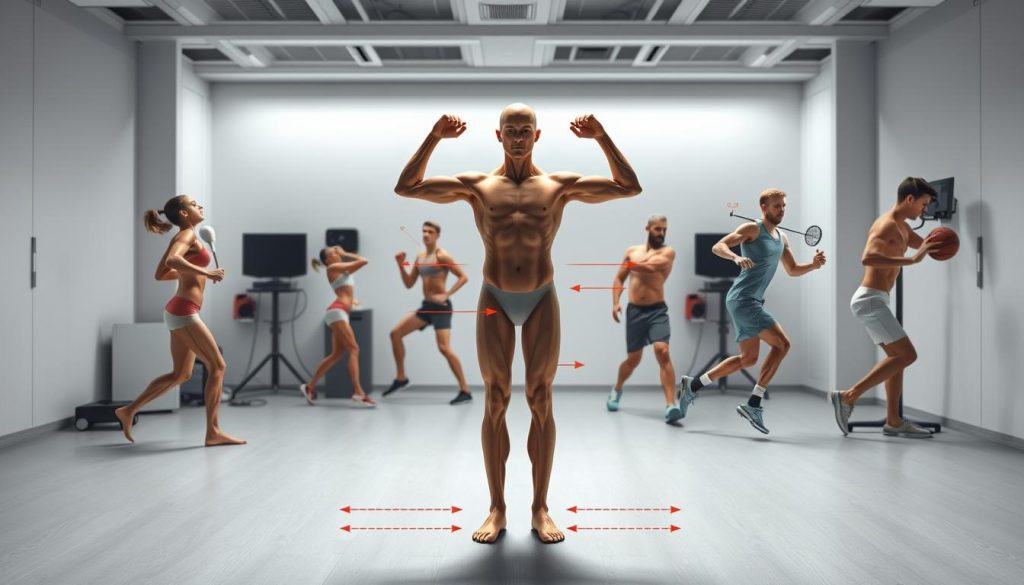
What This Resource Offers
You’ll discover practical methods to improve physical capabilities through motion science. The content covers foundational concepts and new technologies used in athlete care. Each chapter builds on real-world applications for training and recovery.
Why It Matters for Active Individuals
Understanding body mechanics leads to smarter decisions about performance and injury prevention. Key advantages include:
- Enhanced muscle coordination during complex movements
- Data-backed strategies to address weaknesses
- Custom plans matching Alberta’s diverse athletic demands
Local coaches appreciate our focus on measurable progress. Whether refining techniques or rebuilding strength post-injury, this knowledge helps athletes thrive in competitive environments.
Understanding the Fundamentals of Human Movement
The science behind how we move forms the cornerstone of effective training and recovery. At its core, human movement involves intricate relationships between physical forces and biological systems. This knowledge helps professionals optimize performance while reducing strain on the body.
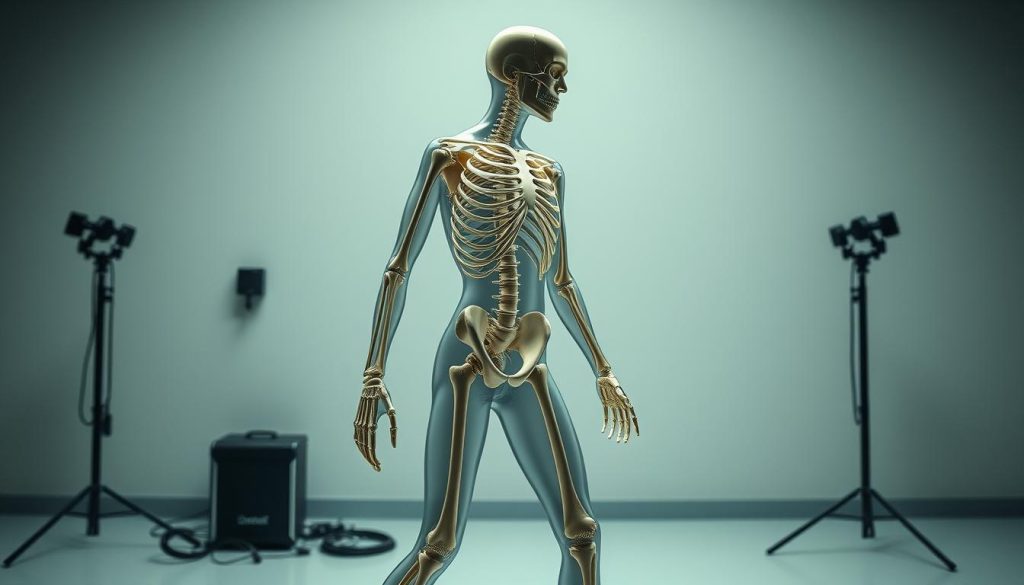
Breaking Down Movement Components
Kinetics examines forces acting on the body during activity. Kinematics tracks joint angles and motion paths. Together, these principles reveal how energy transfers through muscles and bones during exercise.
Motion analysis measures patterns like stride length or shoulder rotation. This data identifies inefficiencies that could lead to injury over time. For example, uneven weight distribution during squats often signals muscle imbalances.
Physics in Action
Every jump, sprint, or throw follows laws of physics. Acceleration depends on force application, while stability relies on proper alignment. Understanding these concepts allows therapists to modify techniques for better results.
Common assessments include gait evaluations and balance tests. These tools help create targeted plans addressing individual needs. Such approaches ensure athletes build strength without compromising joint health.
Mastering these fundamentals prepares athletes for technology-assisted evaluations explored in later sections. By combining theory with practice, movement science delivers lasting improvements in performance and recovery.
Advanced Motion Capture Technologies in Sports Assessment
Modern athletic evaluations now leverage groundbreaking tools that reveal hidden patterns in physical performance. These innovations provide coaches and therapists with crystal-clear insights into how bodies operate during high-intensity activities.
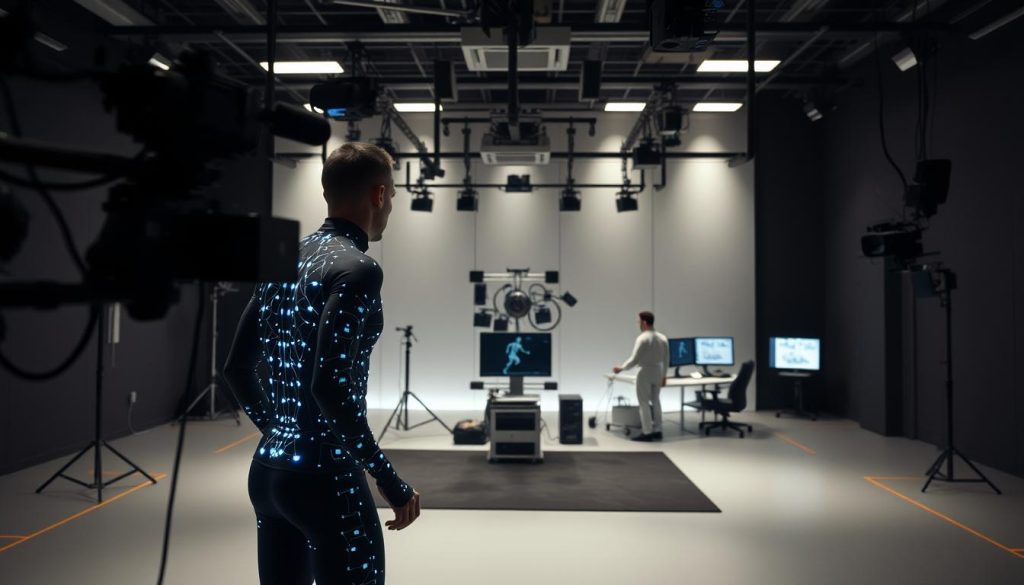
3D Motion Analysis Systems
Infrared cameras and marker-based setups map joint angles across three dimensions. This technology captures rotational patterns during golf swings or weight shifts in hockey stops. Athletes receive instant visual feedback to refine techniques.
Wearable Sensor Technology
Lightweight devices track muscle activation and ground reaction forces during sprints or jumps. A soccer player’s accelerometer data might show uneven force distribution during lateral cuts. Therapists use this information to prevent ankle sprains.
High-Speed Video Analysis Tools
Slow-motion cameras recording at 1,000 frames per second expose micro-movements invisible to the naked eye. Baseball pitchers benefit from frame-by-frame breakdowns of shoulder mechanics. These findings guide adjustments to throwing motions.
Combining these methods creates comprehensive profiles of athletic capabilities. Teams across Alberta use integrated data to design conditioning programs that address specific weaknesses. The result? Stronger performances with fewer setbacks.
Injury Prevention and Personalized Rehabilitation Strategies
Preventing injuries starts with understanding how bodies move under stress. Through detailed evaluations, experts spot hidden patterns that could lead to setbacks. This proactive approach helps athletes stay strong while pushing their limits.
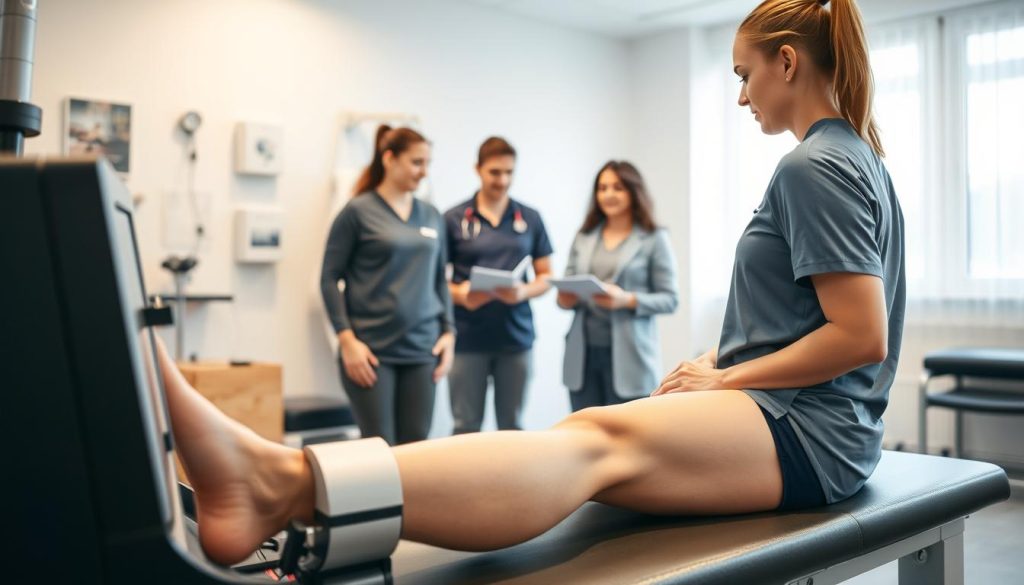
Comprehensive Movement Screening
Thorough checkups examine how joints and muscles work together during activities. Screenings test:
- Joint mobility during squats or lunges
- Muscle activation patterns during jumps
- Balance control on unstable surfaces
These tests reveal weaknesses before they become problems. For example, a runner might show hip instability during single-leg stands. Early detection allows for quick fixes through targeted exercises.
Identifying Risk Factors
Advanced tools measure forces acting on knees, shoulders, and spines during motion. Sensors track:
- Weight distribution during landings
- Spinal alignment when lifting weights
- Foot pressure changes during sprints
One study found athletes with uneven force patterns had 3x higher injury rates. Custom rehab plans then address these risks through strength drills or technique adjustments. This data-driven method reduces strain on vulnerable areas while boosting recovery speed.
Teams use this information to create safer training programs. The result? Fewer setbacks and faster returns to competition after injuries.
Enhancing Athlete Performance with Data-Driven Techniques
Modern athletic success hinges on precise measurements that turn raw numbers into actionable insights. At our Calgary clinic, we use advanced tracking systems to map every aspect of physical output. This approach helps athletes refine their methods while maintaining peak conditioning.
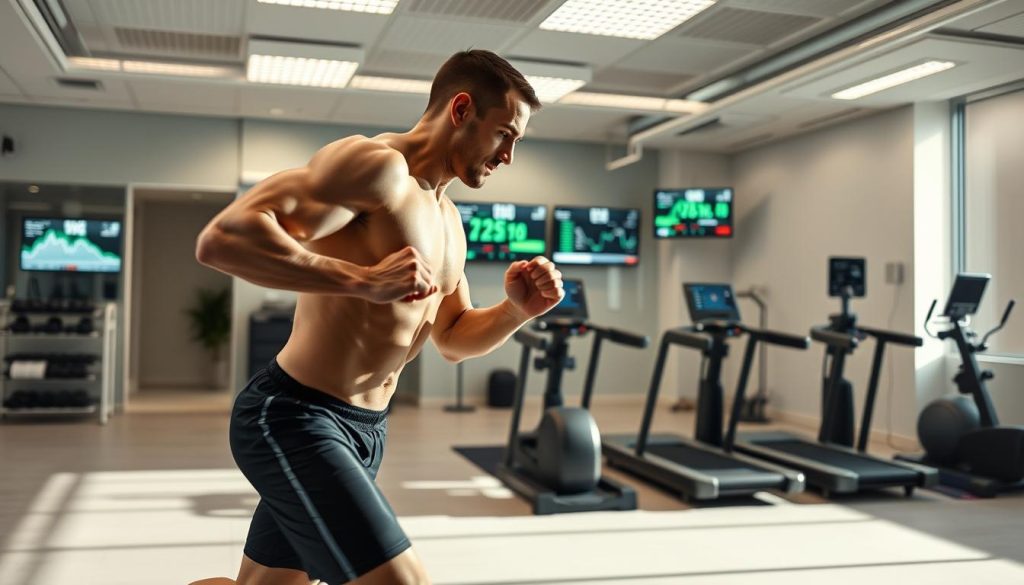
Performance Metrics and Technique Refinement
Wearable sensors and video analysis capture critical details during drills or competitions. These tools measure:
- Power output during jumps or sprints
- Joint angles in complex movements
- Muscle activation patterns under stress
One hockey player improved slap shot speed by 12% after adjusting weight transfer based on force plate data. Regular reviews help athletes spot trends and make targeted tweaks to their form.
| Metric Type | Collection Tool | Impact Area |
|---|---|---|
| Strength Metrics | EMG Sensors | Muscle Balance |
| Movement Efficiency | 3D Motion Capture | Technique |
| Recovery Rates | Heart Rate Monitors | Training Load |
Continuous Progress and Recovery Tracking
Ongoing monitoring ensures training plans evolve with an athlete’s capabilities. Sleep quality measurements and hydration trackers combine with workout data to paint a full picture. A local volleyball team reduced ankle injuries by 40% after matching recovery metrics with practice intensity.
Weekly reports highlight improvements in reaction times or endurance levels. This feedback loop lets coaches adjust drills before fatigue sets in. The result? Sustained growth without overexertion.
Sports-Specific Applications of Biomechanics
Every athletic discipline demands unique physical patterns to maximize results. Specialized movement evaluation tailors training methods to match these requirements, helping competitors excel in their chosen fields while staying injury-free.
Gait Analysis for Running Mechanics
Runners gain critical insights through detailed stride assessments. Motion sensors track foot placement, hip rotation, and ground contact time. This data reveals:
- Optimal cadence for energy efficiency
- Proper weight distribution during foot strikes
- Alignment issues affecting knee stability
One Calgary marathoner reduced shin splints by adjusting her stride length based on pressure plate readings. Real-time feedback helps athletes make instant corrections during training sessions.
Technique Adjustments in Various Sports
Different activities require customized approaches. Cyclists benefit from pedal stroke symmetry checks, while basketball players focus on landing mechanics after jumps. Key modifications include:
- Swimmers refining stroke angles using underwater cameras
- Hockey players optimizing stick handling through grip sensors
- Sprinters adjusting lean angles for better acceleration
A local volleyball team improved blocking success by 18% after analyzing shoulder rotation patterns. These precise tweaks help athletes push boundaries safely and effectively.
Integrating Technology in Treatment Planning
Modern treatment strategies now harness instant data streams to shape athlete care. Therapists combine live metrics with traditional methods to create adaptable recovery plans. This fusion helps address challenges as they emerge during training or rehabilitation.
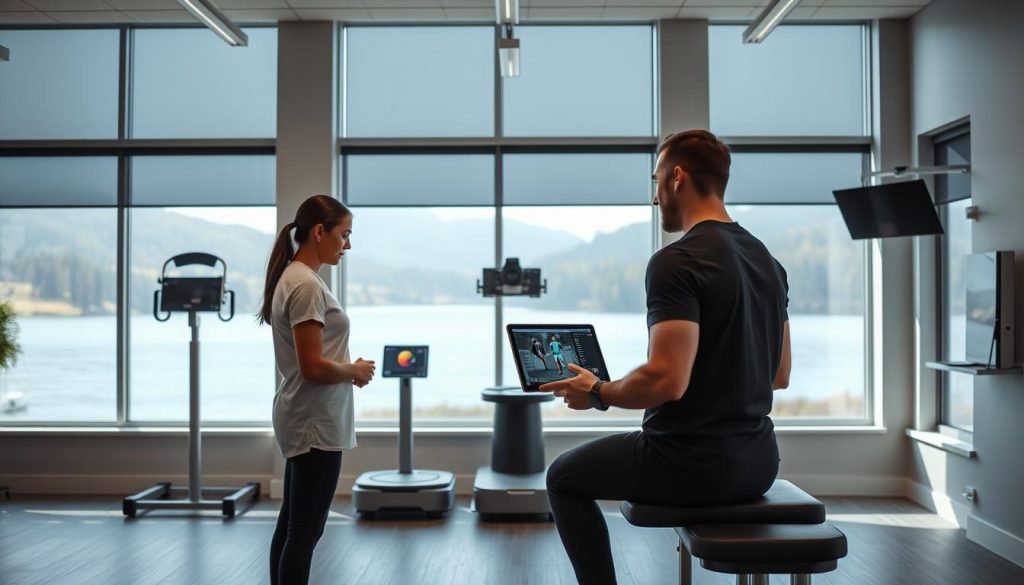
Real-Time Feedback Systems
Wearable sensors track muscle activity and joint loads during exercises. Athletes see instant updates on screens, allowing immediate adjustments. A runner might modify stride length mid-session based on ground force alerts.
Digital Motion Capture and Cloud-Based Data
3D tracking systems record precise body angles during complex movements. Therapists upload results to secure platforms for remote review. Coaches in Alberta access updated reports to monitor progress between sessions.
| Assessment Type | Tools Used | Key Benefits |
|---|---|---|
| Movement Patterns | Infrared Cameras | Identifies asymmetries |
| Force Distribution | Pressure Plates | Reduces joint strain |
| Recovery Tracking | Cloud Analytics | Supports long-term planning |
Continuous monitoring spots subtle changes in health metrics. One hockey player lowered injury risk by 25% after sensors revealed uneven weight shifts during pivots. Therapists adjusted his conditioning program within days.
Combining tech with hands-on care creates balanced treatment plans. As one specialist notes: “Data guides decisions, but human expertise ensures solutions fit real-life needs.” This approach keeps athletes safe while pushing performance boundaries.
Kinetic Chain Assessment and Its Impact on Training
Athletic performance depends on how well different body parts work together during movement. Kinetic chain assessments examine how joints, muscles, and limbs coordinate to produce force. This approach helps therapists spot weak links that might hinder progress or lead to injuries.
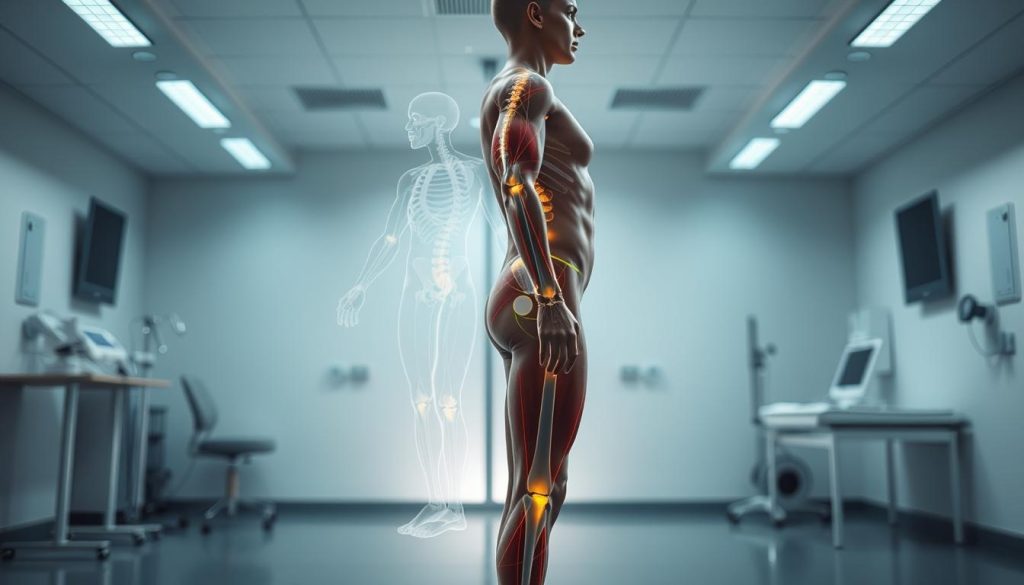
Evaluating Joint and Muscle Interactions
Specialists use motion sensors and pressure mapping to study how forces travel through the body. For example, a volleyball player’s shoulder pain might stem from poor hip rotation during jumps. Assessments reveal:
- Uneven weight distribution between limbs
- Overused muscles compensating for weaker areas
- Joint stiffness limiting natural movement patterns
One Calgary runner improved stride efficiency by 15% after addressing ankle mobility issues found during testing. Therapists combine these findings with strength measurements to build complete body profiles.
Application of Data in Exercise Programming
Assessment results directly shape workout plans. A hockey player with knee instability might receive drills targeting glute activation and foot alignment. Key strategies include:
- Adjusting resistance levels based on muscle balance data
- Modifying exercise angles to reduce joint stress
- Incorporating stability challenges for weak areas
“Data shows where the body struggles, so we design solutions that flow naturally,” notes a local therapist. Regular reassessments ensure programs evolve as athletes grow stronger, keeping training effective and safe.
Implementing Biomechanical Analysis in Sports Therapy for Optimal Outcomes
Turning movement data into real-world solutions requires careful planning and expert interpretation. Clinicians use detailed evaluations to craft treatment protocols addressing specific physical challenges. This process bridges the gap between lab findings and on-field results.
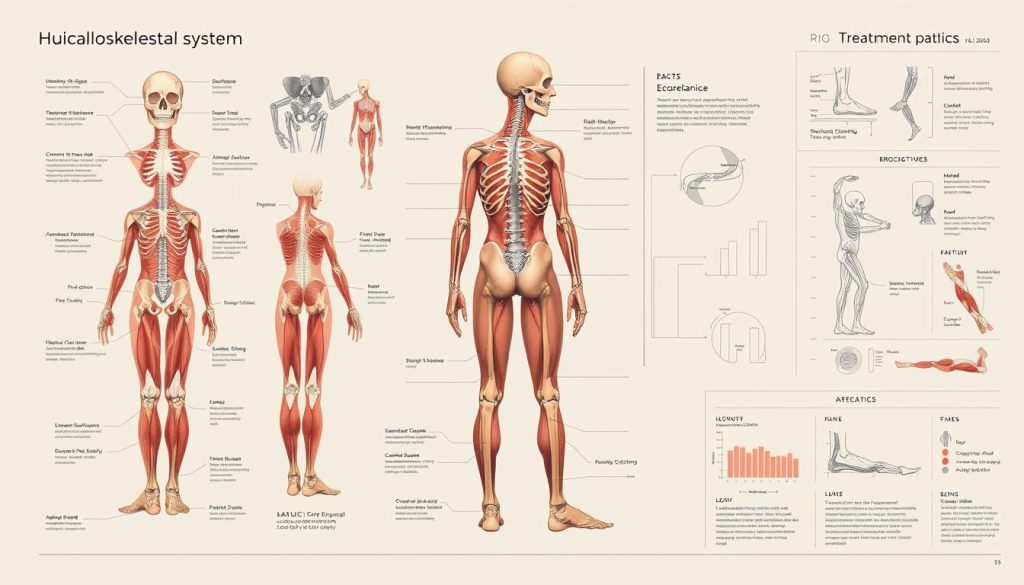
Translating Analysis into Effective Treatment Plans
Therapy plans begin by identifying priority areas from motion capture reports. For instance, a soccer player with recurring hamstring strains might show poor hip alignment during kicks. Therapists then design exercises correcting these patterns while building strength.
Key steps include:
- Matching rehab exercises to movement deficiencies
- Adjusting training loads based on recovery metrics
- Scheduling progress checks every 2-4 weeks
A Calgary marathoner reduced knee pain by 60% through gait retraining. Her plan combined strength drills with real-time footstrike feedback. Continuous monitoring ensured adjustments kept pace with her improving form.
Multidisciplinary teams play a crucial role. Physiotherapists collaborate with coaches to align rehab milestones with athletic goals. One hockey team cut shoulder injuries by 45% using this integrated approach.
Force measurements guide therapy refinements. Sensors track how bodies absorb impact during jumps or landings. This data helps therapists modify techniques before chronic issues develop. “You can’t fix what you don’t measure,” notes a local specialist.
Regular reassessments maintain progress. Updated movement profiles reveal when athletes are ready for higher intensities. This proactive strategy sustains gains while minimizing setbacks.
Riverside Sports Therapy’s Cutting-Edge Approach
Calgary athletes gain an unmatched advantage through our fusion of precision technology and personalized care. Our clinic transforms how movement patterns are understood, creating tailored strategies that evolve with each competitor’s needs.
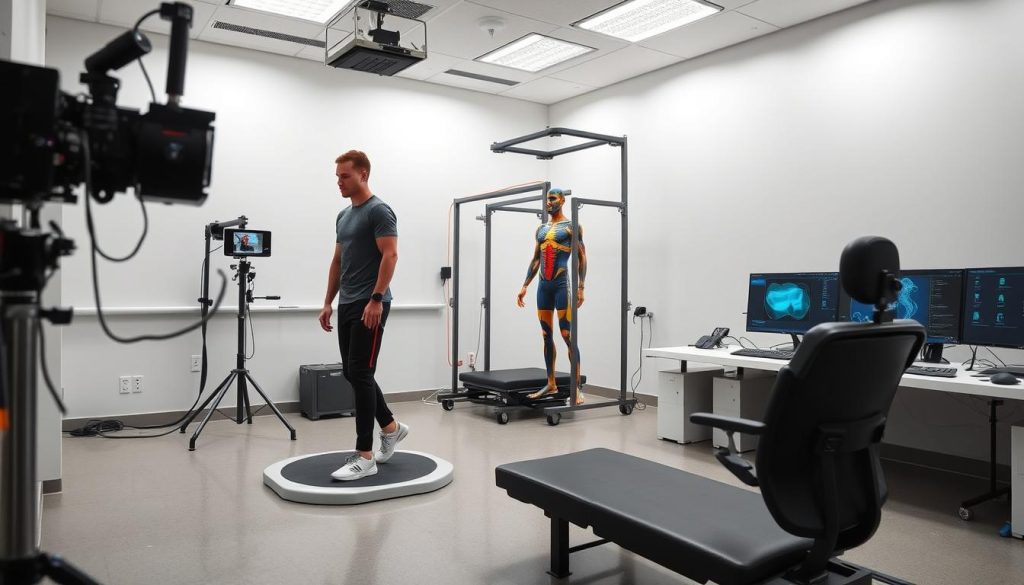
Our Advanced Assessment Tools and Techniques
We deploy multi-layered evaluation systems to map physical capabilities. Real-time sensors and 3D imaging capture data during dynamic movements like jumps or sprints. This reveals hidden patterns affecting efficiency and recovery.
| Technology | Function | Benefit |
|---|---|---|
| Infrared Motion Capture | Tracks joint angles | Identifies asymmetries |
| Force Plate Analysis | Measures ground reaction | Reduces injury risks |
| EMG Muscle Sensors | Monitors activation | Improves power output |
Weekly progress reports help athletes adapt training loads. One local hockey team increased shot accuracy by 22% using these insights. “Seeing data changes how you approach improvement,” notes a Calgary speed skater.
Contact Information and Local Expertise
Our Calgary-based team understands Alberta’s unique athletic demands. Visit us at:
- 📍 123 Performance Way NW, Calgary, AB
- 📞 (403) 555-0198
- 📧 perform@riversidesportstx.ca
Same-week consultations prioritize urgent needs. Over 90% of clients report better movement patterns within 8 sessions. Let’s build a plan matching your goals and local terrain challenges.
Conclusion
Understanding movement patterns unlocks athletic potential while safeguarding long-term health. This guide demonstrates how evaluating physical mechanics helps prevent injuries and enhance performance through targeted strategies. Combining motion science with advanced tracking tools allows personalized plans that adapt as abilities grow.
Improved flexibility and joint function emerge when addressing movement stress early. Continuous progress monitoring identifies risk factors before they become setbacks. Our Calgary-based team specializes in refining techniques – from walking patterns to complex sport-specific motions.
Addressing foot mechanics and muscle imbalances leads to better daily function and recovery outcomes. Proactive care reduces strain on vulnerable areas while boosting range of motion. Clients report lasting improvements in both rehabilitation progress and competitive results.
Ready to optimize your physical abilities? Contact Riverside Sports Therapy today. Our experts combine cutting-edge methods with local knowledge of Alberta’s athletic demands. Let’s build a plan that keeps you moving stronger, safer, and smarter.
